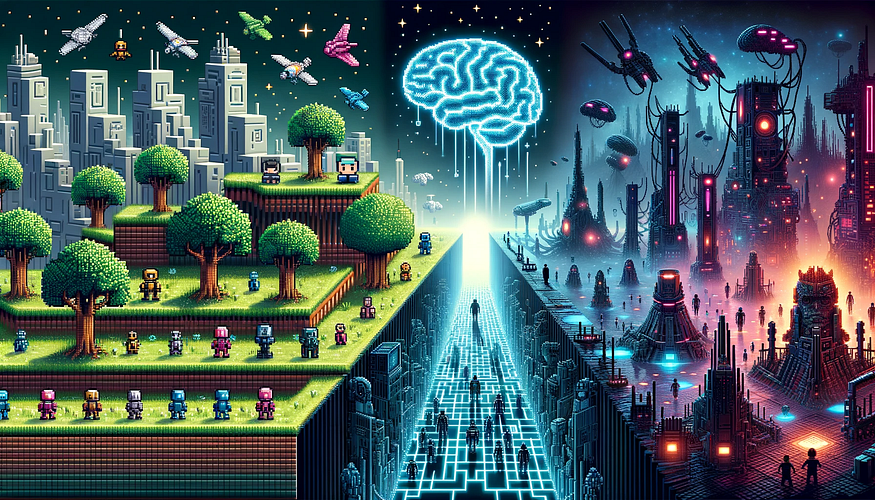For decades, the “intelligence” in artificial intelligence within video games was often a generous term. We remember the predictable patrol routes of guards, the simplistic attack patterns of enemies, and the repetitive dialogue of non-player characters (NPCs). This was the era of scripted, deterministic AI—a system of smoke and mirrors designed to create the illusion of a living world. Today, that illusion is rapidly becoming a reality. A profound shift is underway, driven by breakthroughs in machine learning and deep learning, transforming not just the characters on our screens but the very hardware we use to play. This evolution, a constant highlight in AI in Gaming Gadgets News, is moving beyond simple algorithms to create experiences that are more dynamic, immersive, and personalized than ever before.
This technological leap isn’t confined to game code. It’s being etched into the silicon of our graphics cards, embedded in the processors of our consoles and mobile devices, and is the driving force behind the next generation of immersive technologies. From AI that can master complex strategy games with superhuman skill to hardware that intelligently reconstructs images to boost performance, AI is no longer a peripheral feature; it is the core pillar upon which the future of interactive entertainment is being built. This article explores this revolution, dissecting how AI is reshaping game design, powering next-generation gadgets, and what it all means for the future of play.
The Journey from Scripted Logic to Learning Machines
The history of AI in gaming is a fascinating chronicle of escalating complexity. What began as simple, rule-based systems has blossomed into sophisticated networks capable of learning, adapting, and even creating. This journey marks the transition from programming behavior to cultivating it.
The Era of Finite State Machines and Scripted Behavior
In the early days of gaming, AI was fundamentally about creating predictable challenges. The ghosts in Pac-Man, for instance, followed simple but distinct algorithms—Blinky chased directly, Pinky tried to ambush, and so on. These behaviors were governed by what are known as Finite State Machines (FSMs). An FSM defines a set of states an entity can be in (e.g., “patrolling,” “alert,” “attacking”) and the specific conditions that trigger a transition between them. While effective and computationally cheap, this approach has inherent limitations. Enemies become predictable, their patterns exploitable. Gamers quickly learn that if you trigger condition ‘X’, the AI will always perform action ‘Y’. This predictability, while once a staple of game design, now feels archaic in a world striving for emergent, unscripted experiences.
The Breakthrough: Machine Learning and Neural Networks
The true paradigm shift arrived with the application of machine learning (ML), particularly reinforcement learning (RL). Instead of being given explicit instructions, an RL agent learns through trial and error. It is given a goal (e.g., “win the match”) and rewarded for actions that bring it closer to that goal, and penalized for those that don’t. Through millions of simulated games, the AI builds its own understanding of the game’s mechanics, developing strategies that no human programmer would have ever conceived. Landmark achievements, such as DeepMind’s AlphaStar mastering StarCraft II, showcased AI that could not only compete with top human players but do so with novel and highly creative tactics. This kind of advanced development, often featured in AI Research / Prototypes News, demonstrates a move from AI that follows rules to AI that discovers them.
AI’s Current Role: Enhancing Realism and Gameplay
Today, the fruits of this research are enhancing AAA titles. The NPCs in games like The Last of Us Part II or Red Dead Redemption 2 exhibit far more believable behavior. They don’t just react to the player’s presence; they react to their environment, communicate with each other, and display a sense of self-preservation that makes them feel less like digital puppets and more like inhabitants of a living world. This same technology is finding its way into consumer products, a trend consistently covered in AI Toys & Entertainment Gadgets News, where AI-powered companions learn and adapt to user interaction, mirroring the advancements seen in gaming.
More Than Just Pixels: The AI Inside Your Gaming Rig

The AI revolution isn’t just happening in software. It’s fundamentally reshaping the hardware that powers our gaming experiences. From graphics cards to virtual reality headsets, AI is now a critical component for delivering next-generation performance and immersion.
AI Upscaling and Frame Generation: The DLSS and FSR Revolution
Perhaps the most impactful application of AI in gaming hardware today is in real-time image reconstruction. Technologies like NVIDIA’s Deep Learning Super Sampling (DLSS) and AMD’s FidelityFX™ Super Resolution (FSR) use dedicated AI cores (Tensor Cores in NVIDIA’s case) to achieve what was once thought impossible: rendering a game at a lower resolution and then intelligently upscaling it to a higher one in real-time, with quality that is often indistinguishable from—or even better than—the native image. This process uses a trained neural network to analyze game motion vectors and previous frames to generate new, high-quality pixels. The result is a massive performance uplift, often doubling frame rates and enabling features like ray tracing on a wider range of hardware. This application of computer vision is a leading topic in AI-enabled Cameras & Vision News, showcasing how AI can interpret and reconstruct visual data on the fly. As this processing happens locally on the GPU, it’s a prime example of the power of AI Edge Devices News.
On-Device AI: The Rise of NPUs in Consoles and Mobile
Beyond the GPU, dedicated Neural Processing Units (NPUs) are becoming standard in the System-on-a-Chip (SoC) designs that power everything from smartphones to modern consoles. This trend, a hot topic in AI Phone & Mobile Devices News, allows for low-power, efficient AI processing without taxing the main CPU or GPU. In gaming, this can unlock a host of new features: smarter, more complex NPC logic that runs locally, real-time voice command recognition, and dynamic difficulty adjustment that adapts to a player’s skill level without needing to connect to a server. The integration of AI-driven spatial audio, a focus of AI Audio / Speakers News, can also create more realistic soundscapes that react intelligently to in-game events.
The Immersive Future: AR/VR and Neural Interfaces
Looking ahead, AI is the key to unlocking the full potential of immersive gaming. In the world of AR/VR AI Gadgets News, AI algorithms are essential for everything from precise hand and eye tracking to foveated rendering, a technique that renders only the part of the screen the user is looking at in full detail, saving immense computational power. AI will also power the creation of persistent, dynamic virtual worlds and the believable virtual characters that inhabit them. Further on the horizon, the field of Neural Interfaces News promises a future where we control games with our minds. This will rely entirely on sophisticated AI to decode complex brain signals into actionable in-game commands, representing the ultimate fusion of player and machine.
Beyond the Game: AI’s Expanding Influence on the Gaming Ecosystem
The impact of artificial intelligence extends far beyond the player’s screen. It is fundamentally altering how games are created, tested, and experienced, democratizing development and personalizing play in unprecedented ways.
Procedural Content Generation (PCG) on Steroids
Procedural Content Generation, the algorithmic creation of game data, has been used for years to build large game worlds. However, AI is taking it to a new level. Instead of just generating terrain based on mathematical formulas, generative AI models can now create unique textures, 3D models, character dialogue, and even entire questlines based on a set of high-level goals. This significantly reduces the manual labor required for asset creation, allowing smaller teams to build vast, rich worlds that would have once required a massive studio. This evolution is a major focus of AI Tools for Creators News, empowering developers to focus more on creativity and game mechanics rather than repetitive content production. This is similar to how AI is transforming other creative and professional fields, as seen in the latest AI Office Devices News.

AI as a Development Partner: Debugging and Balancing
One of the most time-consuming parts of game development is quality assurance (QA) and balancing. Developers are now deploying armies of AI agents that can play a game 24/7, exploring every nook and cranny to find bugs, glitches, and game-breaking exploits. These agents can test weapon balance, level difficulty, and economic systems by running millions of simulations, providing invaluable data to the development team. This use of AI for quality control, a topic that overlaps with AI Monitoring Devices News, ensures a more polished and fair experience for the human player at launch. This mirrors advancements in Robotics News, where autonomous systems are used for repetitive and detailed inspection tasks.
The Player Experience: From Matchmaking to Accessibility
For the player, AI is working behind the scenes to create a better experience. Modern skill-based matchmaking (SBMM) systems use AI to analyze player performance and create balanced matches in competitive games. In-game AI Assistants News is a growing field, with the potential for virtual coaches that offer real-time tips and strategies. Furthermore, AI is a powerful tool for accessibility. For players with disabilities, AI can provide real-time captions, describe on-screen events, or even offer alternative control schemes, making games more inclusive. This important work is a cornerstone of AI for Accessibility Devices News and is analogous to the coaching and performance analysis seen in AI in Sports Gadgets News.
The Double-Edged Sword: Challenges, Ethics, and Best Practices
While the potential of AI in gaming is immense, its implementation comes with a unique set of challenges and ethical considerations. Navigating this new landscape requires a thoughtful approach from both developers and players.

The “Uncanny Valley” of AI Behavior
There is a significant risk in making AI *too* perfect. An AI opponent that can predict your every move with flawless precision isn’t fun; it’s frustrating. The goal is not to create an unbeatable machine but a believable character. Developers must carefully tune AI to make mistakes, exhibit “human” flaws, and act in ways that are challenging but ultimately feel fair. The challenge lies in creating AI that is smart enough to be engaging but not so smart that it shatters the illusion of a plausible contest.
Ethical Considerations and Potential for Misuse
The same AI that can power a brilliant NPC can also be used to create sophisticated cheating tools that are nearly impossible to detect. This arms race is a growing concern for online competitive integrity and a key topic for those following AI Security Gadgets News. Furthermore, the data collected to personalize gaming experiences raises privacy concerns. How is player data being used, stored, and protected? Finally, the rise of AI in content creation and QA testing raises questions about the future roles of human artists and testers in the industry.
Best Practices and Key Considerations
- For Developers: Prioritize the player experience. AI should be a tool to enhance fun and immersion, not just to create difficulty. Implement “governor” systems to prevent AI from becoming omniscient and ensure its behavior serves the game’s narrative and design goals.
- For Gamers: Be an informed consumer. Understand what AI-driven features like DLSS or dynamic difficulty mean for your experience. Provide feedback to developers about AI behavior to help them fine-tune their systems.
- For the Industry: Establish clear ethical guidelines for the use of player data and AI in game development. Foster transparency about how AI systems operate, especially in competitive environments, to build and maintain player trust.
Conclusion: The Next Level of Play
The integration of artificial intelligence in gaming is no longer a futuristic concept; it is the present reality and the definitive future. We’ve journeyed from the simple, predictable paths of Pac-Man’s ghosts to the brink of truly emergent, learning systems that can challenge, assist, and create alongside us. This revolution is dual-pronged: it is breathing new life into the virtual worlds we explore while simultaneously revolutionizing the physical hardware that acts as our gateway to them. From the GPU in a high-end PC to the processor in a VR headset, AI is optimizing performance, deepening immersion, and enabling experiences that were pure science fiction just a decade ago. As this technology continues its exponential growth, it promises a future where the line between a game’s code and a player’s experience becomes beautifully, thrillingly, and intelligently blurred.










